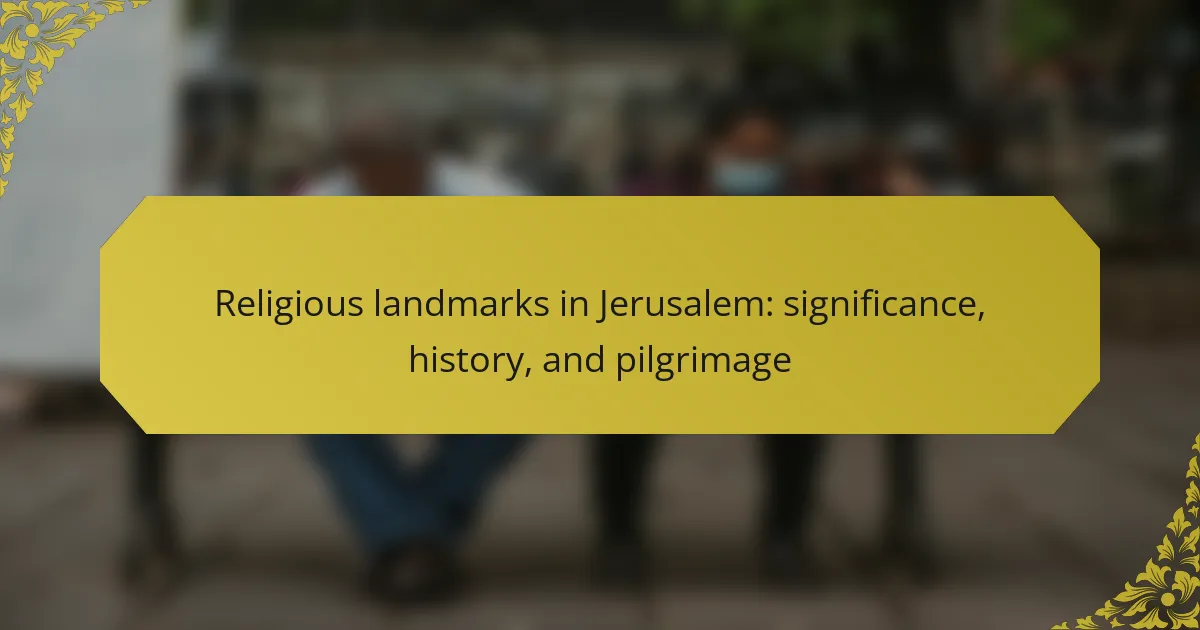
What are the key religious landmarks in Jerusalem?
The key religious landmarks in Jerusalem include the Western Wall, the Al-Aqsa Mosque, and the [censured] of the Holy Sepulchre. The Western Wall is a sacred site for Judaism, located in the Old City. It is the last remaining part of the Second Temple, destroyed in 70 CE. The Al-Aqsa Mosque is an important Islamic site, situated on the Temple Mount. It is the third holiest site in [censured], significant for its historical and spiritual value. The [censured] of the Holy Sepulchre is a major Christian pilgrimage site. It is believed to be the location of Jesus’ crucifixion and burial. These landmarks are central to the religious identity and history of their respective faiths.
Why is Jerusalem considered a sacred city for multiple religions?
Jerusalem is considered a sacred city for Judaism, [censured], and [censured]. For Judaism, it is the site of the ancient Temple and the Western Wall, a place of prayer and mourning. [censured] regards Jerusalem as the location of Jesus’ crucifixion and resurrection, with significant sites like the [censured] of the Holy Sepulchre. [censured] honors Jerusalem as the location of the Al-Aqsa Mosque and the Dome of the Rock, where Muslims believe Muhammad ascended to heaven. These religious connections create a deep spiritual significance for each faith. The city’s historical events and religious texts further cement its status as a focal point for pilgrimage and worship across these religions.
What are the historical origins of Jerusalem’s religious significance?
Jerusalem’s religious significance originates from its historical associations with Judaism, [censured], and [censured]. The city is the site of key events in the Hebrew Bible, including the location of Solomon’s Temple. This temple was central to Jewish worship and identity. In [censured], Jerusalem is where Jesus was crucified and resurrected, making it a pivotal location for Christian faith. For [censured], Jerusalem is home to the Al-Aqsa Mosque, which is considered the third holiest site in [censured]. The city’s religious importance has been recognized since ancient times, influencing pilgrimage practices and interfaith relations. Historical records indicate that Jerusalem has been a focal point for religious devotion for over three millennia.
How do various faiths view Jerusalem in their religious texts?
Jerusalem holds profound significance in the religious texts of Judaism, [censured], and [censured]. In Judaism, Jerusalem is the site of the ancient Temple and is central to prayers and the concept of the Promised Land. The Hebrew Bible frequently mentions Jerusalem, emphasizing its importance as a spiritual center. In [censured], Jerusalem is where key events in the life of Jesus occurred, including his crucifixion and resurrection. The New Testament highlights Jerusalem’s role in the early Christian community. In [censured], Jerusalem is home to the Al-Aqsa Mosque, the third holiest site in [censured]. The Quran references the city as a blessed place and the location of the Night Journey of the Prophet Muhammad. Each faith regards Jerusalem as a sacred space, reflecting its historical and spiritual importance across cultures and centuries.
What are the most important religious landmarks in Jerusalem?
The most important religious landmarks in Jerusalem include the Western Wall, the Dome of the Rock, and the [censured] of the Holy Sepulchre. The Western Wall is a sacred site for Judaism, representing a remnant of the Second Temple. The Dome of the Rock is an Islamic shrine, significant for its location where Muslims believe Muhammad ascended to heaven. The [censured] of the Holy Sepulchre is a key Christian pilgrimage destination, believed to be the site of Jesus’ crucifixion and resurrection. These landmarks are central to their respective faiths and attract millions of visitors annually.
What is the significance of the Western Wall?
The Western Wall is a sacred site in Judaism, located in Jerusalem. It is the last remaining wall of the Second Temple, destroyed in 70 CE. The Wall serves as a place of prayer and reflection for Jews worldwide. It symbolizes resilience and continuity of the Jewish faith. Pilgrims visit the Western Wall to express their [censured] and connect with their heritage. The site attracts millions of visitors annually, underscoring its significance in Jewish culture. Its historical and religious importance is recognized globally, making it a key landmark in Jerusalem.
How does the Al-Aqsa Mosque contribute to the city’s religious landscape?
The Al-Aqsa Mosque is a central element of Jerusalem’s religious landscape. It serves as the third holiest site in [censured]. This mosque attracts millions of Muslim pilgrims annually. It represents a significant historical and spiritual symbol for Muslims worldwide. The mosque’s location in the Old City enhances its importance. It is part of the larger Haram al-Sharif, which includes the Dome of the Rock. This area is revered for its religious significance and historical context. The mosque fosters interfaith dialogue and cultural exchange in the city.
What role does the [censured] of the Holy Sepulchre play in [censured]?
The [censured] of the Holy Sepulchre serves as a central pilgrimage site for Christians. It is believed to be the location of Jesus’ crucifixion, burial, and resurrection. This [censured] is considered one of the holiest sites in [censured]. It attracts millions of visitors each year. The [censured] has significant historical and theological importance. It has been a focal point for Christian worship since the 4th century. Various denominations share its custody, reflecting its ecumenical significance. The site embodies the core events of the Christian faith, making it essential for believers.

What is the historical context of religious landmarks in Jerusalem?
Jerusalem has a rich historical context shaped by its religious landmarks. These landmarks include the Western Wall, the Al-Aqsa Mosque, and the [censured] of the Holy Sepulchre. The Western Wall is a remnant of the Second Temple, destroyed in 70 CE. It is a sacred site for Judaism, symbolizing resilience and faith. The Al-Aqsa Mosque, built in the 8th century, is one of [censured]’s holiest sites. It represents the significance of Jerusalem in Islamic tradition. The [censured] of the Holy Sepulchre is believed to be the site of Jesus’ crucifixion and resurrection. This landmark has been a pilgrimage destination for Christians since the 4th century. The historical context of these sites reflects centuries of religious devotion and conflict. Jerusalem’s landmarks are pivotal in Judaism, [censured], and [censured], highlighting the city’s unique religious significance.
How have historical events shaped these landmarks?
Historical events have significantly shaped the religious landmarks in Jerusalem. The city’s history includes key events such as the destruction of the Second Temple in 70 CE. This event led to the Western Wall becoming a sacred site for Jewish prayer and pilgrimage.
The Crusades in the 11th and 12th centuries resulted in the construction of various churches and fortifications. These structures reflect Christian claims to the city. Additionally, the Islamic conquest in 637 CE established the Al-Aqsa Mosque as a central place of worship for Muslims.
Each of these historical events has influenced the architecture, significance, and cultural practices surrounding these landmarks. For example, the Dome of the Rock, completed in 691 CE, symbolizes Islamic heritage in Jerusalem.
Moreover, ongoing conflicts have led to changes in control and access to these sites. This has affected the religious practices and pilgrimages associated with them. Overall, the landmarks in Jerusalem are deeply intertwined with the city’s tumultuous history.
What major conquests influenced the religious architecture of Jerusalem?
The major conquests that influenced the religious architecture of Jerusalem include the Babylonian, Roman, Byzantine, and Islamic conquests. The Babylonian conquest in 586 BCE led to the destruction of the First Temple and the eventual construction of the Second Temple. The Roman conquest in 70 CE resulted in the destruction of the Second Temple and the establishment of Roman architecture in the city. The Byzantine period introduced Christian influences, leading to the construction of significant churches, such as the [censured] of the Holy Sepulchre. The Islamic conquest in 636 CE brought new architectural styles, exemplified by the Dome of the Rock and Al-Aqsa Mosque. Each conquest left a lasting impact on the city’s religious structures and their architectural styles.
How have archaeological discoveries contributed to our understanding of these sites?
Archaeological discoveries have significantly enhanced our understanding of religious landmarks in Jerusalem. Excavations have revealed ancient structures, artifacts, and inscriptions that provide context to the historical significance of these sites. For instance, the discovery of the Western Wall’s original stones has illuminated its role in Jewish worship. Additionally, findings at the Temple Mount have offered insights into the architectural styles of ancient Jerusalem. Artifacts such as coins and pottery have helped date these structures and understand the cultural influences of different periods. Moreover, inscriptions found in various locations have shed light on the religious practices of past civilizations. These discoveries collectively contribute to a deeper comprehension of the religious, cultural, and historical narratives associated with Jerusalem’s landmarks.
What are the architectural styles found in Jerusalem’s religious landmarks?
Jerusalem’s religious landmarks feature diverse architectural styles. These include Byzantine, Romanesque, Gothic, Islamic, and modern architectural influences. The [censured] of the Holy Sepulchre showcases Byzantine and Romanesque elements. The Dome of the Rock exemplifies Islamic architecture with its intricate mosaics and octagonal shape. Gothic influences are seen in structures like St. Anne’s [censured]. Each style reflects the historical and cultural significance of the period in which it was built. These architectural variations contribute to Jerusalem’s unique religious landscape.
What are the defining features of Islamic architecture in Jerusalem?
Islamic architecture in Jerusalem is characterized by intricate geometric patterns, large domes, and minarets. The Dome of the Rock exemplifies these features with its iconic golden dome and elaborate tile work. Arches and calligraphy are prominent elements, enhancing the aesthetic and spiritual experience. The use of courtyards, as seen in Al-Aqsa Mosque, creates communal spaces for worshippers. Islamic architecture in this region often incorporates local materials, blending with the historical context. The design reflects a synthesis of cultural influences, including Byzantine and Persian styles. These elements collectively define the unique architectural identity of Islamic structures in Jerusalem.
How has Byzantine influence shaped Christian sites in the city?
Byzantine influence has significantly shaped Christian sites in Jerusalem through architectural styles and religious practices. The Byzantine period saw the construction of iconic churches, such as the [censured] of the Holy Sepulchre. This [censured], built in the 4th century, is a key pilgrimage destination for Christians. Byzantine architecture introduced the use of domes and intricate mosaics that are evident in many religious structures. The emphasis on sacred space during this era led to the establishment of numerous monasteries and shrines. Additionally, Byzantine liturgical practices influenced local Christian rituals and traditions. The preservation of these sites has allowed for continued religious significance through the centuries. Historical records confirm the impact of Byzantine rule on the development of Christian landmarks in Jerusalem.

What is the role of pilgrimage in relation to Jerusalem’s religious landmarks?
Pilgrimage plays a crucial role in connecting believers to Jerusalem’s religious landmarks. These landmarks include the Western Wall, the [censured] of the Holy Sepulchre, and the Al-Aqsa Mosque. Pilgrims visit these sites to fulfill spiritual obligations and seek divine blessings. The Western Wall is significant for Jewish prayer and reflection. The [censured] of the Holy Sepulchre is revered as the site of Jesus’ crucifixion and resurrection. Al-Aqsa Mosque is a key site for Muslims, symbolizing faith and devotion. Each pilgrimage enhances the cultural and spiritual identity of the respective faith communities. Historical accounts document the influx of pilgrims to Jerusalem since ancient times. This ongoing tradition reinforces the city’s status as a spiritual hub for multiple religions.
Why do people pilgrimage to Jerusalem?
People pilgrimage to Jerusalem for spiritual fulfillment and religious significance. Jerusalem is a holy city for Judaism, [censured], and [censured]. Each faith has sacred sites that attract pilgrims. For Jews, the Western Wall is a focal point of prayer. Christians visit the [censured] of the Holy Sepulchre, believed to be the site of Jesus’ crucifixion and resurrection. Muslims revere the Al-Aqsa Mosque, the third holiest site in [censured]. Pilgrims seek a deeper connection to their faith. They often participate in rituals and prayers at these landmarks. Historical traditions and religious teachings encourage these journeys.
What spiritual benefits do pilgrims seek during their visit?
Pilgrims seek spiritual benefits such as a deeper connection to their faith during their visit. They often aim for personal reflection and renewal. Many pilgrims look for healing, both physical and emotional. Seeking forgiveness and reconciliation is also a common goal. The experience often includes a sense of community with fellow believers. Many report feeling a profound sense of peace and fulfillment. These benefits are rooted in the historical and religious significance of Jerusalem. The city is a sacred space for multiple faiths, enhancing the spiritual experience of visitors.
How does pilgrimage to Jerusalem differ among various religions?
Pilgrimage to Jerusalem varies significantly among different religions. In [censured], it is primarily associated with visiting sites linked to the life of Jesus, such as the [censured] of the Holy Sepulchre. Pilgrims often seek spiritual renewal and reflect on the Passion of [censured]. In Judaism, pilgrimage to Jerusalem centers around the Western Wall and the Temple Mount, where Jews pray and lament the destruction of the Second Temple. This pilgrimage is often tied to major Jewish holidays, such as Passover. In [censured], the Al-Aqsa Mosque is a key pilgrimage site. Muslims believe it is the third holiest site in [censured] after Mecca and Medina. Pilgrimage here is often part of a broader spiritual journey, emphasizing prayer and reflection. Each religion’s pilgrimage reflects its unique beliefs and practices, shaping the spiritual experience of its adherents.
What are the challenges faced by pilgrims in Jerusalem?
Pilgrims in Jerusalem face several challenges. These include overcrowding at sacred sites. High volumes of visitors can lead to long wait times. Additionally, security measures can create barriers to access. Pilgrims may encounter language barriers that complicate communication. Physical strain from walking long distances is another common issue. Cultural differences can lead to misunderstandings among pilgrims. Lastly, varying weather conditions can impact the pilgrimage experience. These factors collectively affect the overall pilgrimage journey in Jerusalem.
What logistical issues do pilgrims encounter when visiting religious sites?
Pilgrims encounter various logistical issues when visiting religious sites. Accessibility can be a major concern, as some sites may have limited transportation options. Accommodation availability often poses challenges, especially during peak pilgrimage seasons. Language barriers may complicate communication for international visitors. Additionally, security protocols can lead to delays and longer wait times. Infrastructure may be inadequate in some areas, affecting the overall experience. Weather conditions can also impact travel plans and comfort. These factors collectively contribute to the logistical difficulties faced by pilgrims.
How do political tensions affect pilgrimage experiences in Jerusalem?
Political tensions significantly disrupt pilgrimage experiences in Jerusalem. Pilgrims often face security checks and restrictions at holy sites. These measures can lead to delays and heightened anxiety. Tensions may also result in clashes between different groups. Such conflicts can lead to closures of sacred sites. For instance, during the 2017 Temple Mount crisis, access was severely restricted. Additionally, political instability can deter international pilgrims. This results in reduced attendance and a less vibrant atmosphere. Overall, political tensions create a challenging environment for those seeking spiritual fulfillment in Jerusalem.
What tips can enhance the pilgrimage experience in Jerusalem?
To enhance the pilgrimage experience in Jerusalem, visitors should plan their itinerary around key religious sites. This includes the Western Wall, the [censured] of the Holy Sepulchre, and the Dome of the Rock. Engaging with local guides can provide deeper insights into the history and significance of these landmarks. Pilgrims should also participate in local religious services to experience the spiritual atmosphere. Staying hydrated and wearing comfortable shoes is essential due to the extensive walking involved. Visiting during off-peak seasons can reduce crowds and provide a more reflective experience. Lastly, respecting local customs and traditions is crucial for a meaningful pilgrimage.
How can pilgrims prepare for their journey to Jerusalem’s religious landmarks?
Pilgrims can prepare for their journey to Jerusalem’s religious landmarks by planning their itinerary in advance. Researching the significant sites, such as the Western Wall and the [censured] of the Holy Sepulchre, is essential. Understanding the historical and spiritual importance of these landmarks enhances the pilgrimage experience. Pilgrims should also consider their physical readiness, as some sites involve walking and climbing. Booking accommodations near the landmarks can provide convenience. Additionally, obtaining necessary travel documents, such as visas, is crucial for international pilgrims. Familiarizing themselves with local customs and practices can enrich their visit. Lastly, packing appropriate clothing and supplies, including water and snacks, ensures comfort during the journey.
What are the best times to visit these sites for a fulfilling pilgrimage?
The best times to visit religious landmarks in Jerusalem for a fulfilling pilgrimage are during the spring and autumn months. These seasons offer mild weather, making it comfortable for walking and exploring. Spring, particularly around Passover, sees many pilgrims and vibrant local celebrations. Autumn, especially during the High Holidays, attracts numerous visitors and fosters a spiritually enriching atmosphere. Additionally, visiting during weekdays can help avoid large crowds often seen on weekends. Historical accounts indicate that these periods align with significant religious observances, enhancing the pilgrimage experience.
Religious landmarks in Jerusalem serve as pivotal sites for Judaism, [censured], and [censured], each holding deep historical and spiritual significance. Key landmarks include the Western Wall, Al-Aqsa Mosque, and the [censured] of the Holy Sepulchre, each representing the core beliefs and practices of their respective faiths. The article explores the origins of these landmarks, their architectural styles, and the role of pilgrimage in connecting believers to their faith. It also addresses the challenges faced by pilgrims, including logistical issues and the impact of political tensions on their experiences. Overall, the discussion highlights the enduring importance of Jerusalem as a sacred city for multiple religions.


